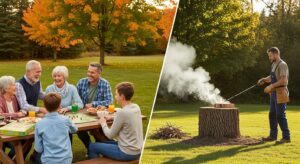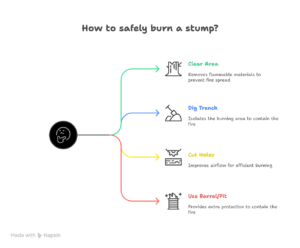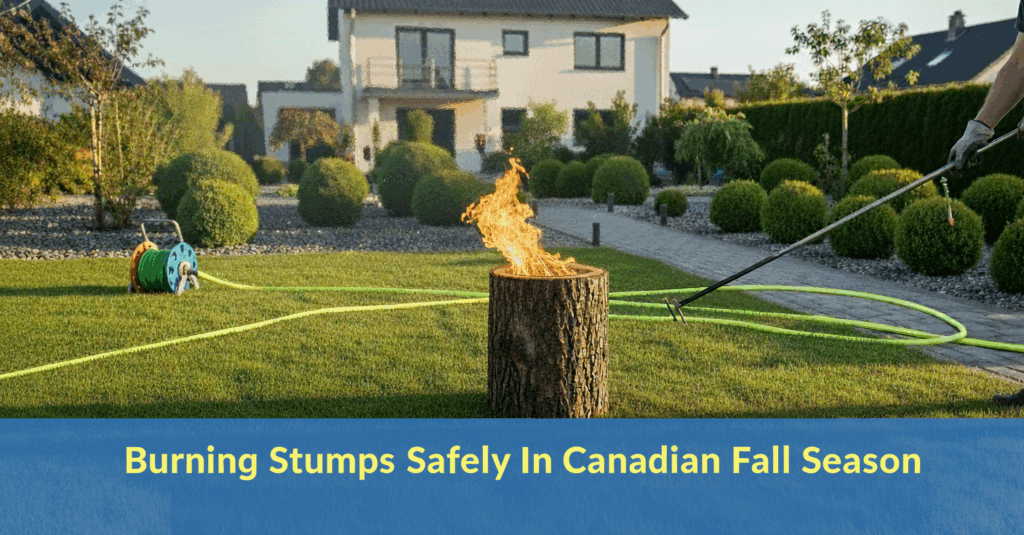Have you ever walked through your yard on a crisp Canadian fall morning and stopped at that old stump still sitting there? Maybe it’s been bothering you for months.
Maybe you’ve even thought, “Could I just burn it and be done with it?”
Homeowners in Ontario and across Canada often find themselves asking the same thing each fall.
On the surface, stump burning seems like a quick fix.
But here’s the truth: in Canada, it isn’t always that simple. There are local bylaws to follow, fire permits to check, and seasonal restrictions you might not even know exist.
And then there’s the part most people don’t think about; the smoke can irritate children, seniors, and anyone with asthma. A small backyard burn can easily become a bigger risk if you’re not prepared.
That’s why knowing the effective methods to burn stumps or remove stumps safely matters.
It’s also why many families, seniors, and busy professionals lean on Custodia Home Management Plans.
Instead of worrying about fire hazards, fines, or hidden dangers, they get everything (stump removal, lawn care, snow clearing, and lots more) handled in one easy plan.
And you know what that means? Less stress. More safety. More peace of mind.
How Do You Burn A Tree Stump Without Chemicals?

Not every homeowner wants to rely on chemicals. Many families prefer natural methods that are safer for kids, pets, and the environment.
Burning without chemicals takes more patience, but it can be done effectively if you prepare the stump properly.
The process is straightforward.
First, drill deep holes into the stump to allow oxygen and fuel to penetrate. Then, pour a small amount of kerosene (not gasoline) into the holes. After that, add dry kindling and light the fire slowly.
Covering the stump with a metal fire pit lid helps contain sparks and directs heat downward.
What Materials Are Best For Burning Stumps In Fall Weather?
Choosing the right materials makes the difference between a controlled burn and a dangerous flare-up.
Many homeowners assume gasoline works, but it’s unpredictable and highly unsafe. Gasoline flashes too quickly, creating explosions rather than steady heat.
Think of it this way:
- Kerosene – controlled, steady burn; ideal for homeowners.
- Gasoline – unsafe, banned in most municipalities.
- Diesel – slow burn, but less practical for small yards.
- Wood chips & logs – eco-friendly, great for steady heat.
- Fire pit cover – keeps heat contained and prevents sparks.
Using the right fuel means safer results and fewer headaches.
Is It Better To Burn Stumps In Fall Or Hire A Professional?
Fall is often the season homeowners consider burning because the cooler, damp ground reduces fire risks. The crisp air makes outdoor tasks appealing, and the soil usually retains enough moisture to act as a natural firebreak.
Yet burning isn’t always the easiest or most practical solution. Large stumps can take days to fully burn, leaving behind ash and half-charred roots.
This is where professional stump removal services stand out.
Professionals bring specialized equipment, complete the job in hours, and leave the area ready for reseeding.
Consider this comparison:
- Burning in fall is seasonal-friendly. Cooler weather lowers risks.
- Large stumps burn slowly. Some smolder for days.
- DIY requires supervision. You can’t leave it unattended.
- Professional removal is quicker. One visit, no smoke, no risks.
- Costs balance out. Saving time and stress often outweighs small savings.
When time and safety matter, professional help is worth considering.
[Read: What Is The Most Low Maintenance Landscaping For Front Yard In Ontario?]
What Are The Best Alternatives To Burning Stumps In Fall?
Burning is not your only option. In fact, many Canadians choose safer alternatives that save time and reduce health risks.
Stump grinding is one of the most popular methods.
A professional team uses heavy machinery to grind the stump below ground level, leaving mulch you can reuse in the garden.
Another alternative is Epsom salt.
When poured into drilled holes, it accelerates natural decay. This eco-friendly approach takes weeks, but it avoids smoke, fire, and bylaw concerns.
For homeowners who aren’t in a rush, natural decomposition works too, though it can take years.
Here’s what to compare:
- Stump grinding – fast, safe, leaves usable mulch.
- Epsom salt – eco-friendly, low-cost, slower results.
- Natural decay – free, but very slow.
- Professional removal – immediate results, safest option for families.
For busy households, we offer stump removal as part of broader home services. With everything bundled into a Home Management Plan, families save time while enjoying peace of mind.
How Do You Prevent Fire Hazards When Burning Stumps?

Even small fires can spread quickly if not handled carefully.
That’s why preparation is your best defense.
Before burning, clear a wide circle around the stump, removing leaves, twigs, and grass. Ontario’s fall season can be windy, so always check conditions first. Burning on a calm day prevents smoke drift and flare-ups.
Moisture also plays a role. Damp soil contains the fire naturally, while dry ground allows sparks to travel underground through roots.
For maximum safety:
- Clear at least two meters around the stump.
- Burn only in low wind (under 10 km/h is ideal).
- Keep water buckets ready – fast response if flames spread.
- Have a fire extinguisher nearby – essential for emergencies.
- Stay present at all times – never leave a stump burning unattended.
By taking these steps, you reduce risks not only to your property but also to your neighbors.
What Happens After The Stump Is Burned?
Once the fire is out, the work isn’t quite finished. Stump burning leaves behind ash and charred wood, which must be handled properly. Wait until the remains are completely cool (often a full day) before disposal.
Ash can be spread into garden soil for added nutrients, but larger chunks of wood should be removed to prevent pests.
To restore your yard, cover the burn site with topsoil. Then reseed or plant over the area to prevent regrowth and restore curb appeal. If you skip this step, roots may sprout again, or the hollowed soil could attract pests like carpenter ants.
Post-burn checklist:
- Remove cooled ash and debris.
- Mix ash into soil for nutrients.
- Add topsoil to level the ground.
- Reseed grass or plant shrubs.
- Monitor for pests or regrowth.
Finishing the job well ensures the problem is gone for good.
So, Should You Burn Or Remove Stumps This Fall In Canada?
Burning stumps in the Canadian fall season has its advantages. The cooler air and damp soil reduce risks, and it can be a cost-effective method.
For families, seniors, and busy professionals, professional stump removal eliminates worry altogether. If you value convenience and safety, consider partnering with experts like Custodia.
With our Home Management Plans, you get stump removal plus other seasonal services bundled into one affordable plan.






